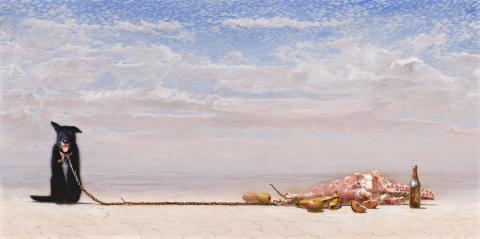BUNCE, BANANA AND HIND QUARTER (BLACK DOG DILEMMA), 2006
TIM STORRIER
oil on canvas
120.5 x 240.0 cm
signed lower right: Storrier; signed, dated and inscribed verso: 'Bunce, banana and hind quarter' (Black Dog dilemma) / Storrier / 2006
Philip Bacon Galleries, Brisbane, acquired 2007
The K.D.H. Ainsworth Collection, Queensland
Tim Storrier enjoyed an auspicious start to his career as the youngest artist ever, at age 19, to win the prestigious Sulman Prize (1968) - his dramatic entry of a leaping motorbike, Suzy 350, literally catapulting him from obscurity into the limelight. Over the ensuing decades, Storrier has continued to attract widespread acclaim for his sublime, awe-inspiring evocations of the archetypal Australian landscape with its blazing horizons and vast celestial skies - iconic compositions which push figuration beyond naturalism into the realm of the hyper-real to create a disquieting, almost 'extraterrestrial' aura. Although often simplistically categorised as 'landscape painting' within this country's tradition of plein-air painters, his achievement is arguably much more complex, betraying greater affinities, albeit indirectly, with his European Romantic and Neoclassical predecessors such as David, Ingres and Delacroix.1 Indeed, as powerfully attested by the present Bunce, Banana and Hind Quarter (Black Dog Dilemma), 2006, Storrier is a master of meticulously composed, psychologically allusive landscapes and still-life subjects which, though clearly derived from the natural world, nevertheless powerfully resonate with symbolic meaning and the artist's own deeply personal vision.
Encapsulating Storrier's enduring interest in the tension between the classical and romantic in his practice, between the disciplined order of his decorative surfaces and the submerged symbolic implications of his subject, thus the still life is here removed from any immediate domestic connotations and placed rather within the more dramatic 'stage set' of the landscape where the metaphoric narrative may unfold. As objects in their own right, certainly the bananas and haunch of raw meat are palpable, sensuous and exquisitely beautiful to paint. Yet more poignantly, they also bear potent allegorical qualities, as Storrier knows well from his travels to Egypt and keen interest in the iconography of the ancients. Food, and especially fruit, has long been associated with fecundity, abundance and prosperity while the meat suggests sacrifice and mortality. Like the best of his oeuvre, here life is once again juxtaposed with death to create powerful allusions to evolution, the passing of time and the grandeur of decay in the same vein as the traditional vanitas still life. As Storrier himself muses, '... there is a relationship between fecundity and mortality ... These are primal poetic qualities that do not change in terms of the human spirit.'2
Featuring his (now departed) favourite old dog, Bunce, in various predicaments " balancing a bottle on his head, struggling with temptation or as depicted here, simply bewildered at the size of the haunch of beef at the end of his chain " the laconic studies that comprise Storrier's 'Black Dog Dilemma' series may also be interpreted on yet another, more personal level. As former director of the Art Gallery of New South Wales, Edmund Capon, suggests of a composition strikingly similar to the present, Bunce and Chain (Black Dog Dilemma II), 2007, where the dog likewise sits chained to a huge slab of meat, '... this is pretty much a self-portrait. The artist is chained to the thing that he loves doing, but is also tortured by it. The length of the chain marks the distance between intention and realisation. The black dog, as Storrier knows, is Winston Churchill's nickname for his depressive moods.'3
Although it would be inappropriate to labour an overtly moral or autobiographical intention for such work (given the artist's own disavowal of such a role for art), the deliberate ambiguity that derives from his unique vision is nevertheless crucial to appreciating the intellectual, as well as sensual, appeal of his art. Fusing the banal with the profound, the ordinary with the extraordinary, indeed the work offers an overall impression of monumentality imbued with personal irony; as Storrier himself muses, 'My vision of the landscape has to do with it being primarily a backdrop for theatre, a stage set for human drama ... I'm not interested in rendering the landscape per se.4
1. Wright, W., Tim Storrier: Boys Own, Sherman Galleries, Sydney, 22 September - 14 October 2006, unpaginated
2. Storrier, cited in Storrier: The Burning of the Gifts, Australian Galleries, Melbourne, exhibition catalogue, 1989, p. 11
3. McDonald, J., 'Dark side of the golden touch', Sydney Morning Herald (Entertainment), 26 November 2011
4. Storrier, cited in Sarks, E., Tim Storrier: A Survey, Orange Regional Gallery, New South Wales, 1993, unpaginated
VERONICA ANGELATOS
